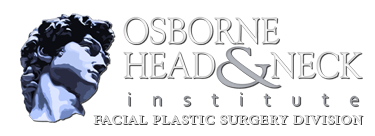Post-Operative Care for Nasal and Sinus Surgery
Please remember that you have just had major surgery. Please do not participate in any heavy lifting, exercise or physical contact unless cleared by your surgeon. If you develop an upper respiratory infection, especially with coughing, please call our office, as this may increase your risk of bleeding.
Diet
It is not unusual for patients who have received general anesthesia to have some nausea and occasionally, vomiting. It is preferable to have clear liquids for the first meal, then thick liquids or a soft diet (macaroni and cheese, mashed potatoes, soups, jellos, smoothies, and ice-cream, etc.) as tolerated. A regular diet may be resumed the next day. Also, pain pills can cause some nausea if taken on an empty stomach. It is preferable to take those pills with a piece of toast or some food.
WOUND CARE AND OTHER INFORMATION
1. Elevate your head at all times. Sit in a recliner or use two or three pillows when sleeping for the first 4-5 days. Head elevation reduces bleeding and swelling. It is okay to use an ice pack over a tissue or a washcloth for 15 minutes at a time for the first two days after surgery.
2. You may take a shower with lukewarm (not hot) water. Make sure you have someone with you in the house in case you feel drowsy or faint from taking pain killers.
3. Do not remove packing or splints if present. You may have to breathe from your mouth if the splints get occluded with mucous or blood clots. This may cause a dry mouth. It is therefore very important to drink a lot and maintain adequate hydration. You may also use a humidifier in your room at night.
4. You may clean the entrance to your nose with a Q-tip soaked in hydrogen peroxide or water. Do not pull on the suture if seen.
5. If you have a splint – Do not get the splint on your nose wet (you may wash your face around the splint). You may wash your hair on the second day after surgery if you can do without lowering your head below your heart. *For women, you may wear makeup at any time if you wish. Please use caution with your glasses or sunglasses/shades.
6. If you have to sneeze, do so with your mouth open.
7. You can expect the following symptoms:
- Bleeding is expected for two to three days after surgery, and also once the packs are removed. Just change the 2×2 drip pad as needed and keep the nostrils clean. Clean the dried blood and secretions from the nostrils with hydrogen peroxide 3% and Q-tips.
- Swelling and bruising around your eyes (sometimes more on the second or third day than on the day after surgery). It is okay to use Arnica cream and/or pills as long as you have no allergy.
- Mild numbness and firmness of the tip of your nose for several months.
- A small ridge along the sides or top of the nose that can sometimes be felt.
CARE AFTER REMOVAL OF PACKS OR SPLINTS
1. Do not blow your nose for at least TWO weeks from the day of surgery. Avoid heavy lifting or straining for four weeks. You may resume walking after two weeks. Running, aerobic exercise and weight lifting may be resumed after four weeks. Avoid any sport that may involve contact to your nose for three months. These activities will increase the likelihood of nasal bleeding.
2. If you have to sneeze, please do it with your mouth open. This prevents excessive pressure build-up and bleeding from the nose.
3. Do not take Aspirin or products containing acetyl salicylic acid. Aspirin prevents clotting and increases your risk of bleeding.
4. For five days after the removal of the nasal splints or packs, use over-the-counter Afrin 0.05% (or generic Oxymetazoline 0.05%), two to three times daily, in both nostrils, if there is bleeding.
5. Otherwise, use saline spray (Ocean Spray, Ayr, Nasal Sea Mist, generic normal saline) six to eight times daily to keep the mucosa moist and to help loosen the crusts for the first two weeks then decrease to two to three times per day.
6. If excessive bleeding occurs, try spraying the nose with Afrin spray to constrict the vessels.
7. Use of sunblock on your nose is strongly recommended for at least three months after surgery.
MEDICATIONS
1. An antibiotic may be prescribed for seven to ten days following the surgery.
2. You may also receive a prescription for painkillers in the form of Tylenol#3 or hydrocodone (Vicodin/ES). These products cause somnolence, drowsiness and constipation. You may not be able to drive while you are taking these painkillers. If constipation occurs, try prune juice and bananas, or over the counter laxatives may be useful for short periods.
3. Occasionally, if nausea or vomiting is severe beyond the first day after surgery, you may need to call the office for a prescription.
4. Sudafed Non-Drying Sinus or Tylenol Cold and Sinus may also be helpful if there is increased facial pain and sinus congestion with headaches.
FOLLOW-UP
Please schedule an appointment to be seen in the office in two to four days for nasal pack removal Your septal splint will stay in place for at least three to seven days.
MEET our doctors TODAY. IN-OFFICE & VIDEO
APPOINTMENTS AVAILABLE
